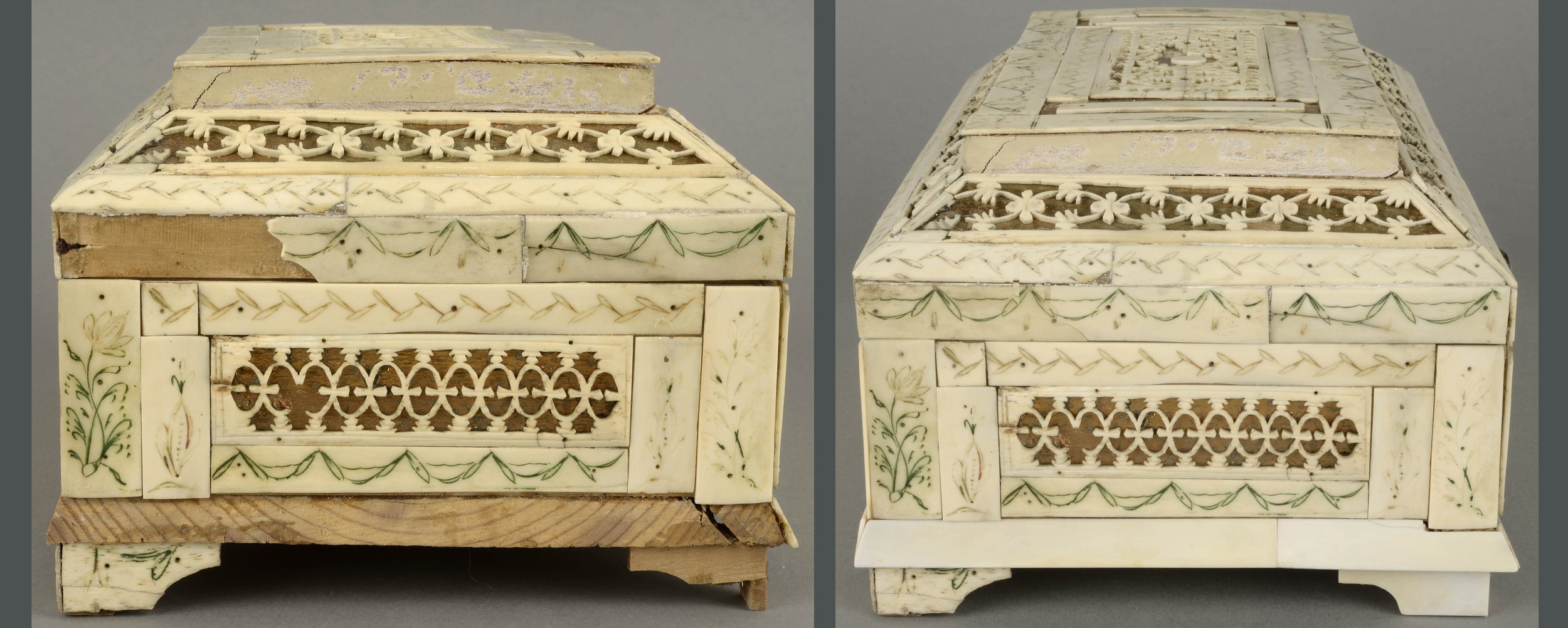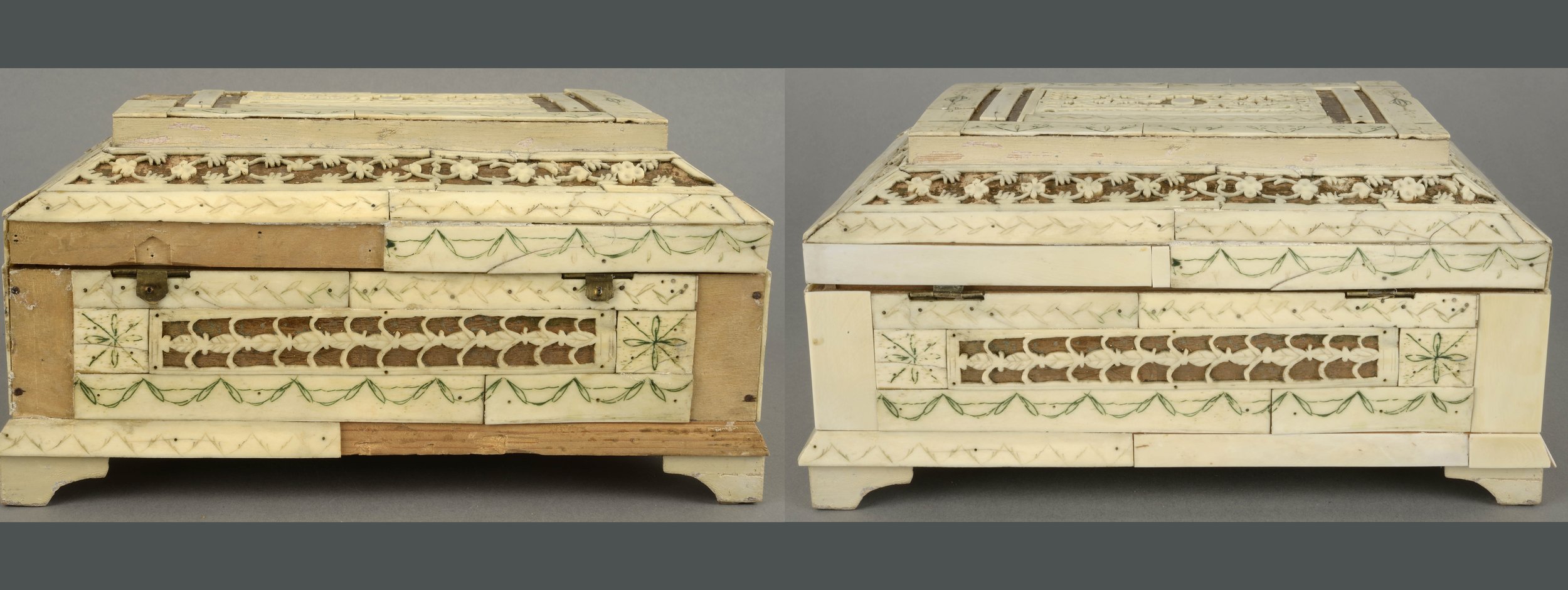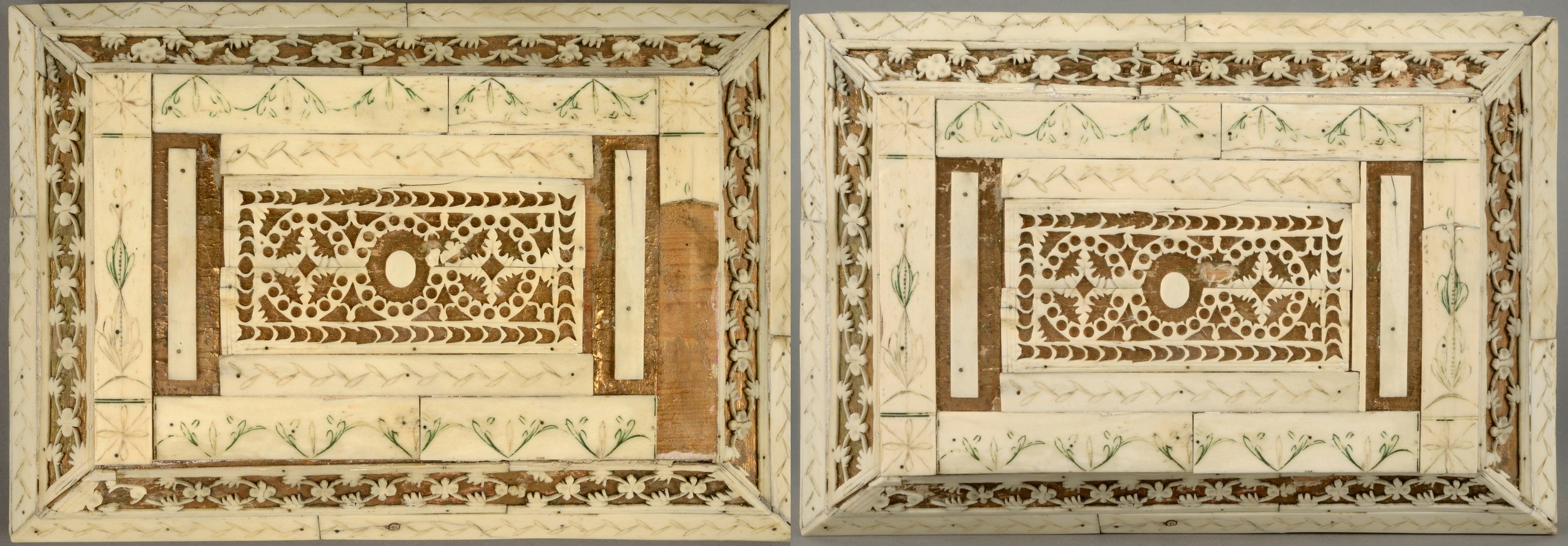CONSERVATION OF A BONE CASKET
Autor:
Aire Aksiim
Number:
Anno 2019/2020
Category:
Conservation
I am describing a bone casket decorated with engraving and gold foil, the beauty and exciting conservation process of which are worth sharing with you. As objects made of bone have been quite rare on my worktable up to now, this item was a provoking challenge.
In addition to some experience with substances like gypsum, ceramics, glass, marble and plastics I was in need of more information and know-how about bone. The problem of restoring the visual entity of the casket became essential – it had to be resolved whether either to replace the damaged details with natural bone material, to find the best plastic imitating bone or just leave the losses untouched.
About bone as a substance in general
Bone is a hard substance of animal origin, that is bones, antlers, sheds, hooves and teeth, the elephant, mammoth and walrus’s tusks included. It can be proceeded to make various objects. viide 1 ⁽¹⁾ Owing to its extensive availability and its yielding to processing, natural bone substance has been used already for thousands of years. Processing bone is a rather time- and labour consuming, mostly manual work. The quality of bone material varies at different localities – the quality of the bone objects has also depended on the traditions and skills of the place. Tools (like axes, wedges, chisels, awls), weapons (spear- and arrowheads, harpoons, fishing-spears), commodities (fans, needles, spindles and ludas – implements for working bark and bass), toiletries (combs, toothbrush hafts, ear-spoons), jewellery and amulets (pins, pendants, beads) and toys (tops, game-pieces and dices, skates). viide2⁽²⁾ viide3⁽³⁾ Bone objects were made of bones of game or domestic animals raised for food.
Attitudes to animals and hunting have considerably changed in time. An international convention has been concluded to curb the extinction of endangered animals and plants – the CITES, i.e. Convention on International Trade in Endangered Species of Wild Fauna and Flora. An agreement that all trading with ivory in all the states that had joined the convention was to be prohibeted was reached at a conference in Switzerland in October 1989, since poaching had already endangered the whole elephant population. viide4⁽⁴⁾ At the animal protectors’ demand the eBay banned all the ivory-containing products. This is the reason for the meagre spread of bone-made objects today. Only artisans making unique ornaments, jewellery and artefacts use the substance now.
Ivory vs. plastics
Ivory has been the most valuable bone substance throughout the centuries. It is luxurious, beautiful, durable and quite easily tractable.
Demand for ivory started growing in the late 19th century. It was not most needed for making artefacts or objects for religious services any more but basically for producing bowling balls and piano keys.
This, in its turn, encouraged inventing synthetic materials. The breakthrough for raw material made on the basis of nitro-cellulose began in 1862 when Alexander Parkes (1813-1890), a British inventor and master in metalwork introduced synthetic ivory at the London World Exhibition. This very first artificial material (polysynthetic thermoplastic) named Parkesine in honour of its inventor was cellulose worked with nitric and sulphuric acids. Another artificial material was launched next year, in 1863. One of the biggest billiards-makers in the USA was looking for someone who could replace expensive ivory for making billiard-balls with some other material. Their newspaper advertising made brothers John Wesley (1837-1020) and Isaiah Hyatt invent a method of coating a tightly wadded paper- and shellac-ball with a thick layer of colloid solution. The brothers called their synthetic ivory Celluloid. The billiard-ball invented by the brothers was in production in the USA already in 1868.
The Hyatts invented the new material for the purpose to imitate ivory and the result was indeed quite similar to the true substance. They imitated even the Schreger lines, so characteristic to bone. To achieve that they had to press several sheets of Celluloid with different transparency tightly together and when these sheets were cut afterwards they showed the expected lines. The new material suited well for objects that had earlier been made of ivory like caskets, boxes, jewellery, articles of toiletry etc. Thanks to the invention of new synthetic materials in the 20th century bone was not so much in demand and objects made of it did not spread so widely any more. viide5 ⁽⁵⁾ .
Traditional Russian engraving
Bone objects are rather scarce in Estonian museums’ collections. One reason for that might be that the local settlements were small and professional artisans working with bone were few even in bigger localities. Nobody passed the true skills to the following generations. No market for bone objects evolved either. Bone was evidently used only in households for making simpler tools and commodities. viide6 ⁽⁶⁾ Obviously the valuable engraved bone objects in our museums have come from somewhere else. [ill 1], [ill 2]
In Russian folk handicrafts, however, bone engraving is one of the most outstanding branches of manual crafts. The two leading Russian centres of bone engraving were Archangel and Tobolsk. viide7 ⁽⁷⁾ The school of bone engraving was established in the 17th century and reached its heyday in the next. The tsar commanded skilled craftsmen to move to the capital and by the end of the 18th century several bone and ivory centres had appeared in St Petersburg. Well-known Kholmogory masters Osip Dudin and Nikolai Vereshchagin also worked there. Their home village Kholmogory in North Russian Archangel region was one of the earliest bone-work centres in Russia, where the workshops of artistic bone engraving had existed already in the 14th to 17th century.
The Kholmogory masters of the 18th and 19th centuries made a lot of traditional folk-art objects like chess-pieces, icons, furniture, snuff-boxes, baskets, lockets, combs, women’s toiletry items and other things. As so many objects were made of the same material each one had to be made distinguished and unique. So a great part of the bone objects have been decorated with deep (about 1mm) carved, grooved, engraved or sawed ornaments. Traditional plant motifs were engraved on the caskets but also lacy patterns consisting of small concentric rings with a dot-eye in the centre were popular. Hence the term eye ornament. Such bone caskets can be seen in several Russian museums. viide8 ⁽⁸⁾ [ill 3], [ill 4]
The casket of the Narva Museum
The casket described in the present article belongs to the collection of the Narva Museum. viide9 ⁽⁹⁾ The museum does not, unfortunately, possess exact data about the origin and former owners of the casket, but it is thought to have come from Sergei and Glafira Lavretsov’s art collection. Sergei Lavretsov (1825-1906) was a merchant in Narva. Together with his art-loving wife they collected mostly Russian but also West-European art. viide10⁽¹⁰⁾ They had paintings, but they also gathered historical European and Russian china and ethnographic and natural rarities. All this together makes up a rather unique collection that reveals the owners’ interests and taste.
Sergei Lavrov bequeathed his art collection and his house to the town of Narva. The Narva Town Museum was established after Glafira’s death in 1913. There had been a museum in Narva already earlier, though. In 1726 Catharine I had bought the house in which Peter I had stayed. This museum did not collect only objects connected with the tsar but other items connected with the town’s history as well. In 1934 Peter’s house-museum was affiliated to the Lavrentsovs Museum (the present Narva Museum). viide11⁽¹¹⁾
Three paper labels and some markings written on wood on the bottom of the bone casket show when the object was registered at different times in the Lavrentsovs Town Museum and/or the Narva Museum (signs: T. I/XXV/N#; KN/1438; NM 652; 2x NLM 1/Aj1: 51; 817). [ill 8]
Description of the casket
The museum has registered the dating from 1800-1850. It is a wood casket with a lid, 11.5 x 15.8 x 23.5cm in size, decorated with bone plates. [ill 5] These bone plates are ornamented with engravings and openwork flower ornaments that give the casket a rather lacy look. The fossae (grooves) in the plant ornament have been shaded green. The backing for the openwork surfaces is gold foil that is visible through the bone lace. The bone plates have been fixed with small nails and glue. The front part has a copper working lock together with a key, but the lid has no fastening on it.
The box part is supported with four wooden legs propped up with a small piece of wood at the back. The legs have been glued on. Their outer sides have been covered with bone plates. The sides of two legs have been painted light, obviously to imitate bone that is missing there. The bottom of the casket is made of solid wood but its sides and lid are made of plywood. The lid is hollow inside and its interlay is of plywood plate.
The plywood used for the casket may hint at the later period of its making than the time the museum has given. It may also be a later-day reconstruction of the casket. In this case the initial bone details have been glued onto the plywood casket. The bone casket might have been made in the late 19th or even the early 20th century, when the masters still used traditional patterns and methods, but might have been using more modern materials instead of solid wood. As it is obviously the work of a Russian master who obtained his material from the vicinity, the plywood may come from local sources. It is known that the Luther Plywood Factory had a branch in Narva at the end of the 19th century and this branch had its own shop in St Petersburg (1897). viide12⁽¹²⁾
The later repairs can be seen in added details, traces of gluing and repainting.
Conservation
The aim of the conservation was to restore the entity and disposability of the museum piece, retaining its originality and its beautiful looks.
Owing to the missing details the surface of the casket was uneven and looked unsteady. Its construction had become loose and the lid did not connect with the hinges. Some details on the bone plates were missing and the lacy pattern was broken here and there. Four bigger bone plates and five details of the bone lace had become loose. [ill 6], [ill 7]
It was decided to reconstruct the missing parts after some deliberation, though. The right material for that seemed to be only something true to its time, that is natural bone and glues that had been recognised as suitable for conservation and would match the bone. The existing loose details had to be fixed and new details had to be made to replace the missing ones. The missing parts of the foil were not filled.
Cleaning the surface
Both the interior and exterior surfaces of the casket were carefully cleaned using a vacuum cleaner with its finest nozzle and a soft brush. [ill 9]
The surface was badly soiled and thus wet-cleaning was needed as well. First of all tests with ethanol, saliva and 2% tri-ammonium citrate aqueous solution were carried out. Saliva was chosen for general cleansing viide13⁽¹³⁾, as it has matching properties for cleaning household dirt and moisture cannot penetrate deeply, leaving aureoles. viide14⁽¹⁴⁾ A bamboo-stick, toothpicks and cotton wool were used to remove the dirt from between the pattern and foil. As the new bone plates were a little lighter than the original ones, it was decided to cleanse the old yellowish ones with 2% tri-ammonium citrate aqueous solution that made them a shade lighter. All the surfaces were proceeded half-dry with distilled water after using the cleaning solutions.
Metal details were cleaned with a glass-fibre pencil and steel wool 0000. viide15⁽¹⁵⁾ [ill 10]
Tidying up the bone plates
Some of the bone plates were loose at the ends and needed fixing up. The old plates were glued with PVA glue. The four loose old plates and the five tiny details of the bone lace were set at their initial places. Pellet-bags and clamps were used for pressing. [ill 11], [ill 14], [ill 15]
A box full of old ivory piano keys had been brought to the Kanut for reusing and the keys were good for making new details to replace the missing ones. These keys actually helped to make the decision about adding new details – usually such a decision is not made when museum pieces are conserved.
The details were jigsawed into right size and their edges were honed with sandpaper. Then the surfaces were polished with nail polish (4000) and a woollen rag. Decorative engravings were not made in order to leave the new parts visible. All in all thirteen new details were made. [ill 12] Three or four dots of PVA glue were dropped under every bone plate to grant an easy removal of them if it became necessary. [ill 13]
The wood of the casket began to shrink and the brittle old glue slackened in our dry workroom (30% humidity). That made us re glue two loosened legs.[ill 16] The loose interior plate had evidently also suffered due to the dryness and so the interlay had to be removed. In the course of this work an idea to leave something for the would-be conservators to discover was realised in writing a dated letter about the conservation process, the name of the conservator and the establishment were included. [ill 17]
The letter written in graphite pencil was fixed on the bottom of the lid with a couple of paste dots in the corners. [ill 18]
Summary
In this article I have attempted to share all the beauty and pain connected with a bone object with the reader. Thanks to the sources I myself got answers to my questions about the history of bone artefacts, the possible origin and dating of the casket, the material and methods used when making it. The bibliography I used showed me how little has been done in Estonia in studying bone as a substance and especially its conservation.
It was a really lucky chance that this box full of old ivory piano-keys had been brought to the Kanut. So it was possible to use natural bone – reusing is wonderful for restoration and conservation.
For summing up I can say that I gained an experience worth having and I can affirm that I did my best to give the lacy bone casket its distinguished looks back, granting its longevity for the museum visitors to enjoy. [ill 19], [ill 20], [ill 21], [ill 22], [ill 23]
Two caskets belonging to the Narva Museum were conserved at the Kanut in 2018. In addition to the casket described in the article above, another wood casket with bone ornaments was spruced up (NLM 1:52Aj. MuISi code 2310226, conservator Jolana Laidma). [ill 1], [ill 2]
Viited
Monika Hint. Luust esemed: toormaterjal, töötlemistehnikad ja tootearendus. University of Tartu. Cultural Academy of Viljandi. MA thesis (2013) http://dspace.ut.ee/bitstream/handle/10062/30723/hint_monika_2013.pdf . (12.06.2019) ↩︎
Toodete elutsükkel/ Luu – iidne ja inspireeriv, https://koordikamber.ee/tooted-and-materjalid (viewed 12 June 2019) ↩︎
Heidi Luik. Luu- ja sarv esemed eesti arheoloogilises leiumaterjalis viikingiajast keskajani. Tartu Ülikool. PhD thesis (2005) [https://www.academia.edu/20497096/Luu-_ja_sarvesemed_eesti_arheoloogilises_leiumaterjalis_viikingiajast_keskajani(https://www.academia.edu/20497096/Luu_ja_sarvesemed_eesti_arheoloogilises_leiumaterjalis_viikingiajast_keskajani) (viewd 12 June2019) ↩︎
Elevandiluu – millise hinnaga? ”ÄRGAKE!” KEENIA-KORRESPONDENDILT https://wol.jw.org/et/wol/d/r37/l p-st/101998206#h=8. (27.07.2019) ↩︎
Karoliine Korol, conservator at the Estonian National Museum, her blog entry, Plastik kui imiteerija on 17 March 2015, https://blog.erm.ee/?p=6044 (viewed on 24 June 2019) ↩︎
Monika Hint. Luust esemed: toormaterjal, töötlemistehnikad ja tootearendus. University of Tartu, Viljandi Culture Academy, MA thesis (2013) http://dspace.ut.ee/bitstream/handle/10062/30723/hint_monika_2013.pdf (viewed 17 July 2019) ↩︎
Государственный художественный музей г. Ханты-Мансийск. Декоративно-прикладное искусство, http://www.hmao-museums.ru/museum/ghm/gallery/1794/?v=gallery#ci17101 (viewed 30 July 2019) ↩︎
Государственный художественный музей г. Ханты-Мансийск. Декоративно-прикладное искусство. http://www.hmao-museums.ru/museum/ghm/gallery/1794/?v=gallery%20-%20ci17101#ci17054 (viewed 30 July 2019) ↩︎
Estonian Museums Public Portal (MuIS). Narva Museum. History collection. NLM 1:51 Aj 1:51. https://www.muis.ee/museaalview/2440189 (viewed 30 July 2019). The presented images are state-of-art photos before conservation; after conservation photos have not yet been added to the portal. Kanut uploads the documentation and images into the museums’ digital store. ↩︎
Kärt Hellermaa. Narva kunst Tallinnas. https://kultuur.postimees.ee/2520795/narva-kunst-tallinnas (viewed 12 June 2019) ↩︎
Aleksandra Murre. Lavretsovide kunstikogu Narvas – tuntud või tundmatu? http://www.sirp.ee/s1-artiklid/c6-kunst/lavretsovide-kunstikogu-narvas-tuntud-voi-tundmatu/. (viewed 12 June 2019) ↩︎
Tõnis Möldre. Lutheri vabrik kui Eesti mööblitööstuse teerajaja. https://www.aripaev.ee/uudised/2006/03/14/lutheri-vabrik-kui-eesti-mooblitoostuse-teerajaja (viewed 24 July 2019) ↩︎
Saliva is a liquid secreted in the mouth, complicated in its content, transparent, colourless and slightly alkaline (pH 7…8). 98% of it is water. It contains mucous polysaccharides, enzymes and electrolytes. Its enzymes are amylase (carbohydrates-splitting) and lingual lipase (fat-splitting). https://et.wikipedia.org/wiki/S%C3%BClg
(viewed 24 July 2019) ↩︎Paula M. S. Romao, Adilia M. Alarcao, Cesar A. N.Viana. Human Saliva as Cleaning Agent for Dirty Surfaces. – Studies in Conservation 35 (1990), 153–155.
Editor’s summary of the article: Many conservators have preferred to use saliva for cleansing sensitive surfaces (like painting, gold foil, ceramics, et al). Generally they argue that this kind of cleansing is the least damaging to the surface or that this method has always been used. Attempting to support the argument with scientific proof and expecting to find a more hygienic way of applying it, the research project described in the article was carried out.
Five polychrome and gilded objects (from the 18th century) were tested with different cleaning solutions and the cleansing effects were compared. Testing solutions were white spirit, iso-octane, toluene, diluted ammonium hydroxide, saliva and the enzyme a-amylase.
The tests showed that saliva had ‘the best’ cleansing effect.
The cleansing effect of saliva is explained with its enzyme action. Surface dirt dissolves better as the enzymes in it catalyse the dirt dissolution. Besides saliva can cleanse due to the active water in it. ↩︎Glass-fibre pencil AUG1474.1 (importer Elmatik OÜ, Männiku Rd 104, Tallinn 11216). Terasvill n0000 Liberon 100g (Ehituse ABC, OPTIMERA ESTONIA AS) ↩︎























